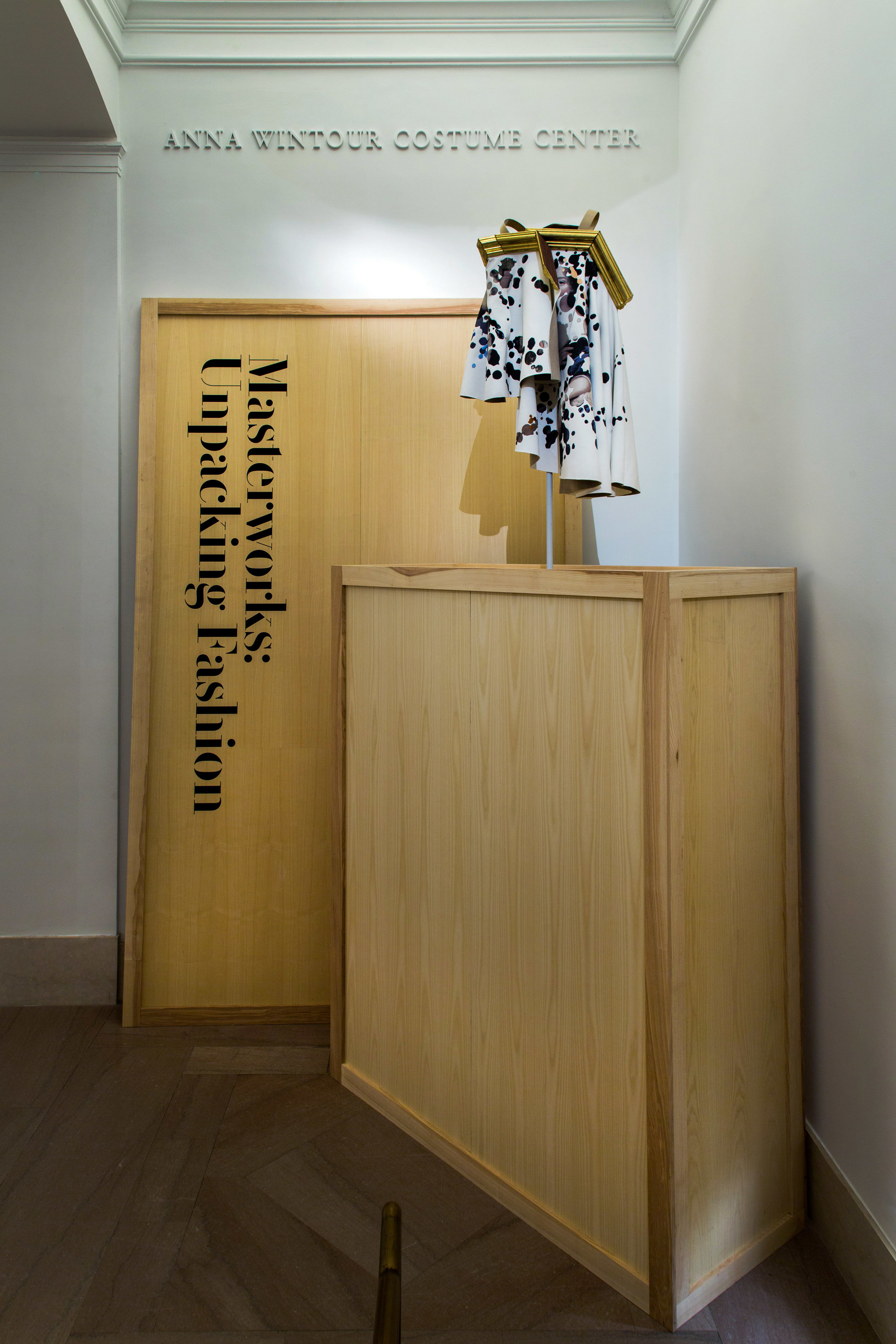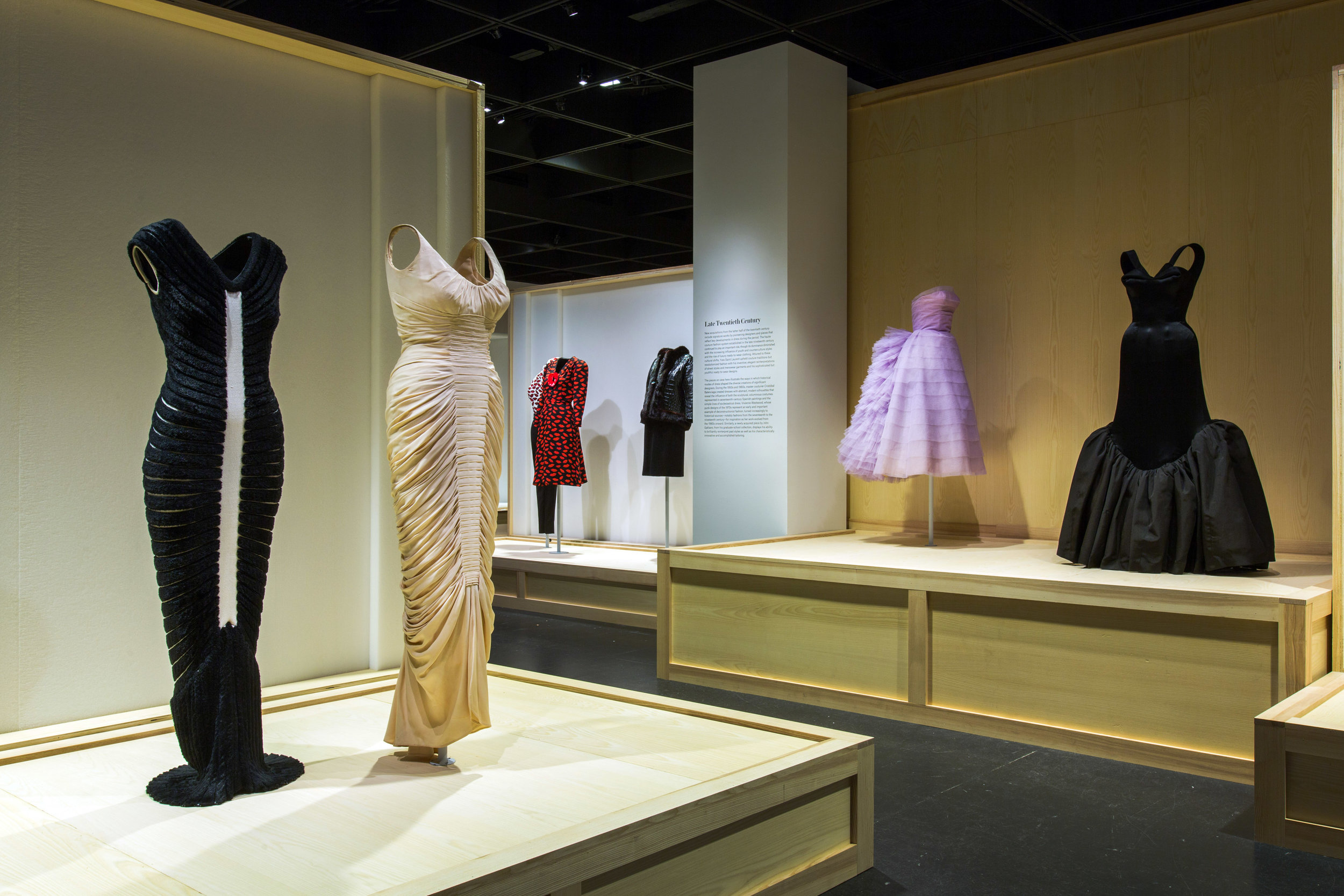Masterworks: Unpacking Fashion
Metropolitan Museum of Art (New York, NY), November 18-February 5, 2016
Spending time peacefully contemplating a dress or a shoe is a pleasure increasingly under attack. It can feel almost revolutionary to relinquish your phone, to escape the throbbing sense of doom in the headlines, and allow things of beauty to massage your mind. Good news: Internet reception is spotty in the Anna Wintour Costume Center at The Metropolitan Museum of Art. It always seems vaguely insulting to be sent into the basement for Costume Institute exhibition. On the other hand, however, it creates a vacuum that permits one to truly escape and to meditate on this jewel of a show in privacy.
Unpacking is The Met’s version of an unboxing video: “Look at all the cool stuff we’ve bought in the last decade!” I usually prefer the institute’s lowkey exhibitions to high-minded conceptual shows like Punk: Chaos to Couture. (And the less said about Superheroes the better.) Here, the literal yet unobtrusive exhibition design constructed from utilitarian wooden shipping crates lets the objects breathe.
The show pairs recent acquisitions with older ones, for an interplay that might be too subtle for the average viewer. How the robe volante (new) interacts with the robe à la francaise (old) in the first gallery frankly puzzles me. In the 17th century, women adopted a more prominent role in fashion design, which led to a greater emphasis on uncut textiles. Indeed, fabric, it may be said, is a feminist issue. The older purchase is made of a silk faille with polychrome thread that we’ll never see again. Definitely droolworthy. Meandering through the galleries, I passed a Spitalfields silk dress dribbled in silver cartouches, an exhausted-looking gown by Charles Frederick Worth, and an awkwardly displayed robe de style by Jeanne Lanvin. It was only when I set eyes upon a spectacular Schiaparelli creation that my pulse began to quicken.
My fashion history professor at the Fashion Institute of Technology told us Elsa Schiaparelli made the best jackets of the twentieth century. Looking at this one, a 1937 collaboration with surrealist polymath Jean Cocteau, you’ll know she sure as hell did. (Note to self: watch Cocteau’s magical Beauty and the Beast again.) Why is this garment, rendered in gray plain weave linen with gold bugle beads and blue strip, so moving to me? It probably shouldn’t be; there’s too much embellishment (courtesy of Lesage). The specter of Alexis Carrington on Dynasty, all that ’80s excess, hovers. Embroidered elements form the figure of a woman whose face rests on the wearer’s right shoulder while her golden hair shimmers down the sleeve. Maybe it’s the deep imagination and patient craft that were lavished on it? Whatever. The piece is mysteriously “pure”—one of the great symbioses of fashion and art.
In the early 30s, Joan Crawford reportedly returned from Paris with some Schiaparelli designs and told MGM costumer Gilbert Adrian to imitate them. His best work was for Crawford, Greta Garbo, and the munchkins, though he went on to create plenty of period-appropriate suits and dresses for his own house after World War II. Robert Riley, the first curator of what would become The Museum at FIT, referred to Adrian’s strategy of building out the shoulders to minimize the client’s waist as a “trick,” and Vogue editor Diana Vreeland dismissed Adrian as mere Hollywood. He deserved better than that, but The Met pits him against Schiaparelli and it’s not a fair fight. Adrian’s dress uses rayon fabric designed by Salvador Dalí to pleasantly jarring effect, and includes a witty shoulder detail, not unlike Schiaparelli’s. On the whole, it’s not bad. But it’s not Schiaparelli either.
Nearby, there’s a far more plausible conversation going on between Charles James and Azzedine Alaïa. James’s La Sirène (like Worth, he titled his creations; he was an “artist”) was the earlier purchase, and it’s easy to see why The Met needed the Tunisian’s elegant rejoinder. When the museum mounted its Charles James exhibition in 2014, visitors passed through the ancient Greek galleries to see it. This struck me as perfect: The poetic drapery and folds (in marble!) of the classical statues reminded me of art historian Anne Hollander’s observation that the Greeks lived naturally with cloth. [1] Then you proceeded into the James show to see how we Americans don’t. Never have outfits seemed more tortured, more worked (and worked-over), than with James. Jan Reeder’s outstanding catalogue detailed the suffering—drug abuse, temper tantrums—that went into his fashion. Alaïa’s mirror-image of James shrugs all that off.
“When museums transform fashion into art, do we forget it’s also clothing? ”
In Adorned in Dreams, Elizabeth Wilson pointed out that the way fashion is displayed on mannequins in museums short-changes the viewer’s experience because clothes needed to be seen on the human body, in motion, for the full effect; otherwise, they have a tendency to seem haunted. [2] I recalled this observation while looking at arguably the best piece in the show, a killer swoop of poison-green gazar by Basque couturier Cristóbal Balenciaga. Ralph Rucci told me he liked using gazar (emphasis goes on the second syllable) because he could sculpt outfits with it. If you want to see a dress as sculpture you don’t have to squint too hard here. (The aloof geometry of Brancusi’s Bird in Space comes to mind.) The display makes ingenious use of hidden magnets to hold the train in place, though part of the dress is stuck in a corner; it should slowly spin, so we get the full 360.
When museums transform fashion into art, do we forget it’s also clothing? I loved the slight discoloration at the base of the armhole, a suggestion of the woman who wore it. Fashion blurs the categories of fine art and functional object; that’s what makes it so interesting. However, I am becoming fatigued by the use of videos in exhibitions, staged, we can only assume, to bring the garments to life. The giant screens that blared the Bertolucci movie clip in China: Through the Looking Glass struck me as obnoxious and distracting (perhaps that was the intent, given all the queasy-making orientalism on display). However, it would be fascinating to hear the former owner of this particular dress—Judith Straeten, once a Met curator herself—describe what it was like to wear it.
In the same vein, fashion is unmistakably tactile. We all know it’s a no-no to touch the objects, but once in a while museums should accommodate this impulse. A friend at FIT brought me a sample of gazar, a high-twist fabric, usually silk, that feels wonderfully stiff, tulle-like. Apparently it’s also hydrophobic, impossible to steam. If the museum set out a swatch for visitors to fondle, it would complement our understanding of the piece nicely.
The day I visited the show, I wasn’t wearing a safety pin, that symbol of solidarity with minorities that some progressive Americans donned after November 8. In this new content, the pin seemed to suggest a binding together of causes and sentiments, but in the safety-pinned works of Zandra Rhodes, Donatella Versace, and Vivienne Westwood on display at The Met, it reflects dissolution, chaos, anarchy. I write this to point out how unstable meaning is in fashion, how ill-suited it is as a medium for transmitting political messages.
Politics does relate to fashion of course, in innumerable ways. As historian Nancy L. Green pointed out, New York wouldn’t have had a fashion industry without Jewish, Italian, Puerto Rican, Dominican, and Chinese immigrants (and immigration, long a cherished aspect of Americanness, has recently become political again). We wouldn’t have an industry at all without the mass production techniques pioneered to create uniforms for the Civil War. Couturière Alix Grès became a hero in fashion history by creating a collection using the colors of the French flag in Paris during the occupation. In November, Women’s Wear Daily reported that designer Sophie Theallet refused to dress Melania Trump. Good for Theallet, I say, though I wonder about the significance of the gesture. Individual designers can make whatever statements they want, but fashion itself is mercenary; it goes where the money is. Ronald Reagan notoriously ignored AIDS, but Nancy read Women’s Wear religiously, and became known for her Adolfo and Galanos. She was a fashionista, “ours” whether we liked her politics or not.
If Theallet won’t create clothes for Melania, maybe Karl Lagerfeld will. Lagerfeld won my admiration forever for insisting that fashion is an applied (as opposed to fine) art; he can be infuriating but he’s never boring. His 2011 reinterpretation of Chanel’s classic tweed suit in this show brings all of his dynamic iconoclasm to the fore—he leaves Coco in tatters—and is really something to see. If you’ve ever pulled a greatly beloved article out of your closet and realized it’s been savaged by moths, you’ll recognize the horrified feeling. Lagerfeld dares you to hate him, and the fact that he doesn’t care what you think makes his work all the more compelling.
Melania probably wouldn’t wear this suit. It’s not really Nancy Pelosi’s style either, but some smart progressive should wear it; it captures the ruined feeling, the feeling of being in tatters, so brilliantly. I do think The Met should try to keep Ivanka out entirely, however. She’d surely knock something off for her own line—perhaps the Yves Saint Laurent looks from the early ’70s. They’re significant pieces from his oeuvre, but man do they look trashy. I did look around for Melania, though. What would she wear?After much hemming and hawing, I finally settled on a pair of bedazzled football jerseys by Tom Ford and Geoffrey Beene for the next first lady. She seems like a team player.
Remember artist Barbara Kruger’s dictum, “When I see art, I take out my checkbook”? It’s still worth pondering, no matter how dated it is. (Not quite as dated as her October cover of New York Magazine, on which she branded Donald Trump “LOSER”. Oops.) On my way out of The Met, I hit the gift shop and bought something wonderful: a book by Alain de Botton and John Armstrong called Art as Therapy. Perfect! Over the next four years, we’re going to need a lot of it.
Acknowledgements
Many thanks to Patrice George of FIT’s Textile Development and Marketing Department, and Nicole Bloomfield, conservator at The Museum at FIT, for the observations about gazar.
Notes
[1] See Anne Hollander’s chapter “Drapery” in Seeing Through Clothes (New York: Avon Books, 1978), 1-82.
[2] See Elizabeth Wilson, Adorned in Dreams (New York: I.B. Tauris, 1985).



